CEO Blog - Advice for CEOs on growth and scaling
The Traditional Marketing and Sales Funnel is Dead. Welcome the Intelligent Sales Pipeline™!

Improving Your Lead Generation and Qualification Processes
Mark Coronna, Area Managing Partner & CMO, Chief Outsiders
with Jeff Parris and Daniel Steyn, Fractional Sales Executives, Sales Xceleration
Sometimes we take certain business models for granted. The model of a “funnel” to represent a sales pipeline is certainly one example. Dusting off its past, a gentleman named E. St. Elmo Lewis is generally given credit for initiating the idea of a funnel in 1898. The author is also credited for introducing the first formal theory of Marketing.
It would be amazing that a model like a funnel would still find relevance 120 years later. There have been previous attempts at calling the funnel “dead.” In a 2016 article in Marketing Week, Mark Ritson declared that “If you think the funnel is dead, you have mistaken tactics for strategy.”
We wouldn’t call a traditional marketing and sales funnel either a strategy or a relevant tactic based on how most companies use it today. And, that’s why we are declaring it dead. There’s simply a better way of thinking and operating and we are calling it an “Intelligent Sales PipelineTM, a new process for proactively managing lead generation and lead qualification using prospective customer data intelligence, engagement, and metrics.
The Problem with Funnels, Generally
A funnel can be your friend when you are trying to fill up your lawnmower with gas. Their physical use is to narrow materials into a manageable stream. Funnels are used for transfer, distillation, separation and other physical tasks.
You can likely guess why E. St. Elmo Lewis came up with the idea of using the funnel model to describe the process of narrowing choices so that, in the end, the buyer has reached the point where yours’ is the only option available. In the early days of Marketing, the twin ideas of personalization and buyer journeys weren’t developed. The challenge in 1898 and beyond has been how to efficiently sort out the wheat from the chaff. Mass marketing and undifferentiated markets reinforced the funnel model. Today, personalization, one-to-one marketing, and mass customization increasingly deliver individual solutions and make the traditional funnel model obsolete.
The funnel process is less of trying to guide the buyer as much as it is forcing the buyer into a series of transitional steps which we prescribe. These steps are often task-based, such as reading a white paper or viewing a demo. The problem is that buyers have their independent mindsets, pain points, challenges, and goals, which then create problems for the business employing the funnel. Those darn prospects just don’t do what we want them to do!
Problems with Traditional Funnels as a Sales Pipeline Model
Traditional sales funnels are very inefficient. They put a lot of material in the top (i.e. unqualified suspects or prospects), and after a period, some dramatically reduced number of qualified leads are expected to emerge out the bottom for us to convert into customers or clients. As a process, the traditional concept and application of a sales funnel is very flawed. Effective and efficient processes have short cycles and therefore operate at lower costs as they deliver quality results. They have high throughput and productivity. We’d like to highlight these specific issues with a traditional funnel model.
The Problem of Time: Buyers don’t necessarily want to follow your process or wait for you to encourage their movement and journey. They operate in increasingly shorter cycles as their service expectations change.
The Problem of Sequence: Today’s buyer journey is anything but linear or one-way. It jumps around as new information is introduced to the rational brain. Some clever companies try to graphically show this non-linear movement inside of a funnel model graphic, but that doesn’t address the real problem of independent prospect decision-making.
Problems of Quantity and Cost: Acquiring a mass of unqualified leads just won’t work economically today, even if you get them inexpensively. One of the worst problems you can create for your business is a high volume of unqualified leads. Someone will likely be proud of the 12,000 visitors you get every month on your website but think of what the cost per lead looks like if you extract only 1 or 2 qualified leads each month. And consider the sales time it takes to plow through a high volume of leads to find your ideal buyers.
The Problem of Lead Quality: Another typical problem is the low sales productivity which a funnel model creates. In manufacturing, an example we see relates to challenges sorting consumer inquiries from OEM inquiries based on poor quality leads created by “wide net casting” associated with expanding top of the funnel productivity “at any cost.” Too often these businesses get inquiries from consumers looking to replace a lighting fixture instead of inquiries from the lighting manufacturers who represent their target buyers. Only after wasting time screening the inquiries are they able to screen poor quality prospects out. And labelling them “prospects” may be generous, since many of these are really either “suspects” or not leads at all.
The Problem of Control: If you think you can control the buyer’s journey, think again. You might be able to shorten it in the ways that Amazon has with personalized recommendations and one-click ordering—but real control, it’s not possible. While you can influence through education and insight, you can’t dictate what options your buyers are considering or the prices your competitors are offering. It can be difficult to make your priorities also your customers’ priorities with regard to the pace at which they move through the sales process and therefore their place in the funnel. You can’t control the signals that their primal brain receives or the emotional response to them as they evaluate options. For those interested in this topic, the authors encourage you to take a look at a new book called The Persuasion Code if you want to learn more about how the primal brain works in decision-making.
Problems of Capacity and Backflow: It’s an ugly picture when you keep filling funnels beyond their size and capacity with what many of us know as “junk in, junk out” approaches. This makes the funnel less predictive of the trajectory of the business. Poorly qualified leads crammed into funnels to make sales leadership feel better create sales forecasting problems which create “spills and backups” that slow the sales organization from operating at the most appropriate pace. You have some control over the size of the funnel since you could add more people to process leads through your system.
Let’s face it. There was a time and place for the traditional funnel model, but it is over.
Replacing the Traditional Funnel with the Intelligent Sales Pipeline™
Instead of funnels, let’s talk “Intelligent pipelines!” We hear about pipelines in the oil and gas business and there is something worth observing about the nature and role of physical pipelines. Intelligent pipelines use technology to more efficiently and more quickly move oil and gas from A to B.
In the oil and gas business, there’s even a company with the name “Intelligent Pipeline Technologies.” Their value proposition is: “Intelligent Pipeline Technologies provides reliable, innovative and industry leading pipeline diagnostic and integrity solutions through leading edge technologies that will add efficiency to your work flow.”
Who wouldn’t be interested in reliable, innovative diagnostic solution to add efficiency to your sales pipeline workflow? Higher quality opportunities go into an intelligent pipeline and higher quality leads come out while reducing or eliminating leakage, waste, and extended time delays. A much better model for creating leads and managing those through the sales process to manage and predict performance.
An Intelligent Sales PipelineTM operates very differently than the traditional funnel model. Selling today is much more of a conversion process, built on a level of intelligence-gathering and engagement. The “Intelligent” part of the new model comes from a proactive process of identifying and engaging prospects in a more effective process and dialogue. “Engagement” is prospect-focused. It has a definite focus on improved metrics.
Intelligence: The switch from a supplier and task-focused way of processing leads to a prospect-centered, smart way using criteria that are important to both you and the prospect.
Engagement: Building rapport and a deeper understanding of pain points, needs, challenges, and goals through deeper interaction with a smaller number of prospects.
Metrics: Starting with higher quality, better fit prospects at the beginning of your interaction, and placing more emphasis on quality versus quantity metrics.
The following characterizes the new, intelligent pipeline model:
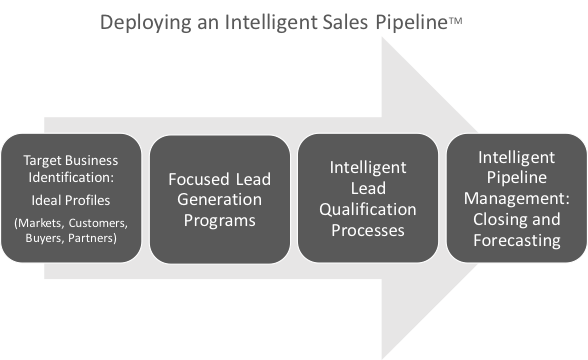
Let’s do a brief guided tour of the Intelligent Sales Pipeline.
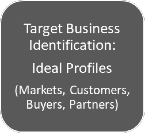
The model starts with an identification of your ideal customer and buyer. Ideal customers may be based on previous long-term, high value customer relationships, or may represent new customer profiles with whom you wish to build new relationships. Ideal buyers are the specific individuals in those ideal customers you want to cultivate.
Ideal Customer Profiles often include factors such as:
Demographic Factors
Size and Growth: revenue, employees
Location and Business Scope: local, regional, national, global
Prior Business Relationship: current customer, lapsed customer, prospect
Strategic Fit Factors
Fit with Your Value Proposition (e.g. recognize value or price shopper)
Fit with Your Capabilities, Product and Service Offering
Long-term Potential (e.g. are they transactional or relationship buyers?)
Ability to Serve Them Profitably (can we make our target margins on this business)
Buying Factors
Willingness to Communicate Openly About Their Strategies
Openness to Discuss Projects or Needs, Share Concerns, and Discuss Options
Buying Process (RFPs or can we present ourselves uniquely?)
Ideal Buyer Profiles represent specific roles within the prospect’s organization for your sales team to focus on. Some of these roles or personas have more influence and decision-making authority than others. An important task is understanding the various stakeholders involved in making what is often a collective decision on a complex service or product. Each stakeholder may vary in influence and it may be difficult to understand any “final” decision-maker.
As an example, typical influencers and buyers for a Manufacturer often include:
VP of Engineering
COO / VP of Operations
VP Product Design/Development
VP Procurement & Supply Chain Management
Intelligent Sales Pipelines start by understanding which organizations make the best business relationships. The Intelligent Pipeline places significant emphasis on pre-qualifying prospects. Let’s move on to an even more critical next step.
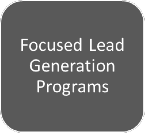
Focused, proactive lead generation starts with these four questions, and the last three are much more important than the first one:
What markets should we be in, based on their size, growth, and competitive coverage?
Are these good markets for us, and can we win?
Can we find our ideal customers and buyers in these markets?
Can we find our ideal customers efficiently and effectively?
If you have answered these four questions affirmatively, then you’ll need to design a proactive go-to-market plan. By proactive, we mean an intentional plan to identify your ideal customers and buyers and communicate with them effectively.
This is the first challenge in implementing an Intelligent Sales Pipeline: finding appropriate contacts and companies by pre-qualifying them and starting the conversation. We’re using the word “conversation” purposefully. Quality leads are developed after you have developed a rapport with your prospective customer. You’ll need to be able to discuss their strategy, understand their product or service needs, and also understand the prospect’s individual needs and goals. You’ll match their needs with your product or service offerings and ultimately how your organization help this organizations and its stakeholders win and fulfill objectives. These are all essential outputs in a thorough qualification process. And to have those conversations, you will quickly need to position your organization as having something valuable and relevant to offer.
Pre-qualification is a critical step. If you are following the guidelines of an Intelligent Sales Pipeline, then you have already defined with whom you want to do business. Instead of dumping a large quantity of unqualified leads into this pipeline, you carefully curate leads that match your Ideal Customer Profile and introduce them into the process.
An effective website is only one lead source, and unfortunately is not ideal for hosting conversations. Creating and maintaining a best-in-class website with highly relevant content and highly optimized search is the foundation for all good go-to-market programs, but it alone is insufficient as you are still relying on your target customers to find you through their search actions. You could implement a more holistic and proactive go-to-market program if you add pay-per-click for the keywords associated with your unique value proposition. Layer in targeted online advertising and these programs may generate an ROI that should be at least perhaps 3x your marketing investment.
There are many ways of being proactive outside of your internet marketing initiatives. One of the best ways is to implement an account-based marketing program (ABM). Account-based marketing programs start with your ideal customer and ideal buyer profiles within respective target markets in which organizations use a third party to contact and qualify leads will help your sales organization be more productive. You can read more about account-based marketing programs.
Please be careful not to confuse account-based marketing with older cold-calling sales approaches. It’s quite different, and here’s an excellent article highlighting the differences.
As you improve your target profiling, the quality of your lead stream will improve. Your focus should be on quality over quantity. You may not be getting 12,000 visitors per month on your website, but if you are getting 2,000 per month and you are getting 10% to a qualified stage it would be significantly higher and return a greater investment than a “spray and pray” approach that characterizes a garbage in, garbage out funnel model. By implementing the Intelligent Pipeline approach your organization will be able to pivot to a model that creates “Marketing Qualified Leads” that become “Sales Accepted Leads,” a process by which organizations evaluate the lead generation process and ensure better conversion rates. A handoff score of 100% means that every lead your Marketing team is generating and pre-qualifying is acceptable to your Sales team. Your sales organization will be much happier not having to screen poor quality prospects out and their productivity will improve as they can now concentrate on deeply qualifying the higher quality opportunities generated.
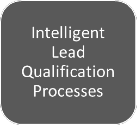
Let’s get to the core of the Intelligent Sales Pipeline approach by translating our ideal market, customer, and buyer profiles into a way of directly qualifying prospects. The traditional approach is to qualify prospects based on tasks your sales organization has performed. Often, an organization’s CRM platform embeds this approach.
In task-based qualification, every task completed until a prospect is closed as a customer is given a percentage score. For example, an initial verbal qualification may be assessed at 10%, if you give a prospect a demo it might be assessed at 50%, when you send in an RFP is might be 70%...you get the model. Going further, often businesses multiply the percentage score against the size of the deal. Organizations using this approach might look at a potential $1 million deal at 50% task completion and project a value of that opportunity as $500,000. This method of scoring may be misguided as the deal is worth nothing if you lose it, or $1 million if you win it, but it will never be worth $500,000. This type of math has value largely in helping leadership understand overall size and trajectory of a pipeline over time.
In the Intelligent Sales Pipeline model, we qualify and score prospects based on their answers to the factors we map out in the ideal customer profile. We can use this approach to profile and qualify other businesses and organizations with whom we might want to partner such as channel partners.
Here’s an example based on qualifying industry associations as a potential channel partner. In this scenario, a business uses third party industry associations as a marketing and sales channel to reach their members. How can you proactively select and invest in the associations that will perform the best for you?
Together with the client, we developed a profile for an “ideal association partner.” In addition to identifying the key partnership criteria in the profile (24 criteria in this example), we also developed a scoring model for each criterion with a maximum of 5 points each. Then, we assigned a point score for each criterion based on qualification conversations with each respective association. Criteria highlighted in gray were identified as the most important.
In the example below, this association scored “96” out of a potential “120” possible scores—indicating an excellent fit with our business and therefore, a priority partner.
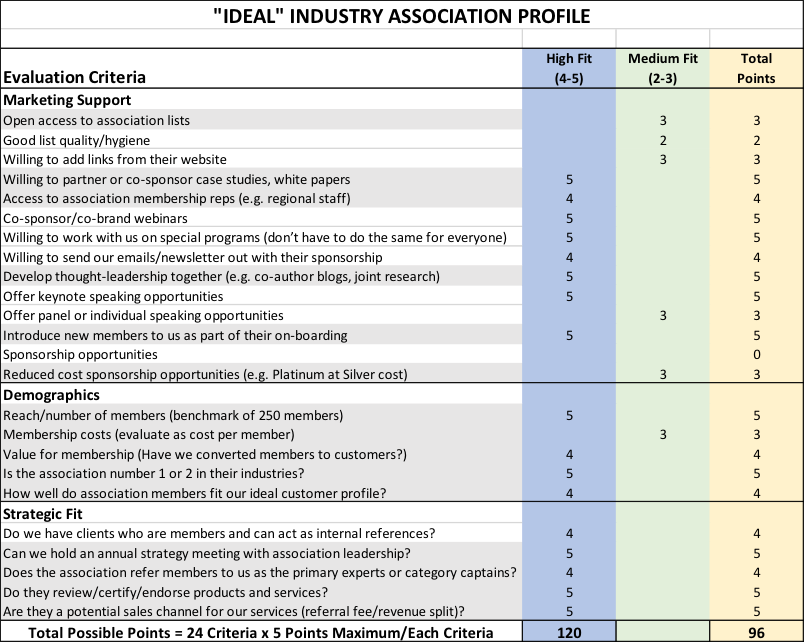
If you believed that this association relationship could contribute an incremental $1 million to your business, by building a sales script and engaging this prospect to validate and confirm your initial scoring, you would feel very happy adding this channel partner to your go-to-market program. The ratio of this actual score to the total possible points is 80%. There’s a powerful rationale behind this approach, and as you further qualify this prospect you could adjust the points accordingly. This example shows how both intelligence and engagement work together.
This example dramatizes the difference between a sales funnel built on a series of task-based steps and an Intelligent Sales Pipeline based on criteria and responses that are stronger indicators of the future value of this relationship. It’s all about intelligence-gathering and engagement.
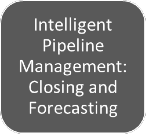
With improved qualification using the Intelligent Sales Pipeline approach, your sales organization will be able to have deeper, more valuable interactions with your best prospects. The qualification steps left to complete include qualifying budgets, qualifying the decision-maker and decision process (you have already identified the best roles through your ideal buyer profiling), and negotiating the final purchase price, terms and conditions.
The efficacy of the Intelligent Sales Pipeline models manifests through different indicators. The first indicator is active leads from the Intelligent Sales Pipeline closed, measured as a percentage of qualified leads. You may be able to reach closing rates of 25-30%, which will far exceed industry averages. You will also likely see increases in average order/deal sizes. Probably most significantly as you take a longer view of customer value, you are likely to see higher customer lifetime values—driven by longer-term, higher margin business from each customer.
These types of metric are paramount to measure, manage and predict performance. These two charts dramatize the dynamics of the traditional funnel model and the Intelligent Sales Pipeline.
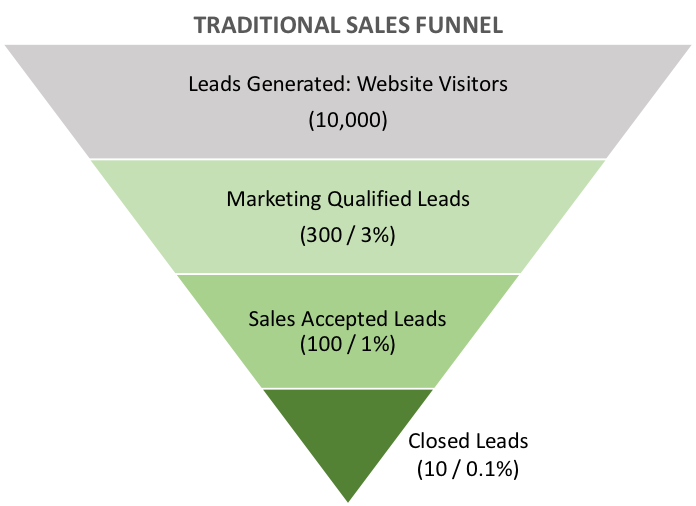
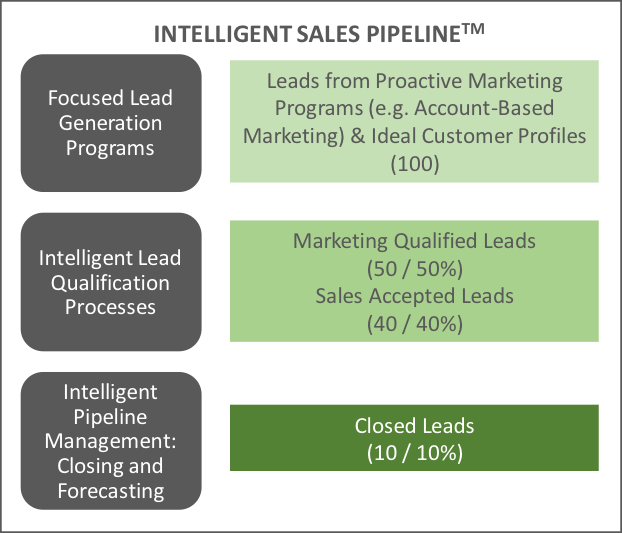
Thinking differently about the funnel as an Intelligent Sales Pipeline acknowledges the value of all the critical front-end pipeline activity that needs to happen to drive the following advantages:
- fewer nonqualified suspects or prospects to process
- lower customer acquisition costs
- dramatically improved sales productivity
- reduced time from suspect/prospect to closed customer
- strong probability of higher customer lifetime value because you have qualified “fit” and you have engaged the customer in a more intelligent way.
Summarizing the Value of an Intelligent Sales Pipeline™ Approach to Lead Management
This comparison chart compares the intelligent approach with a task-based sales funnel approach.
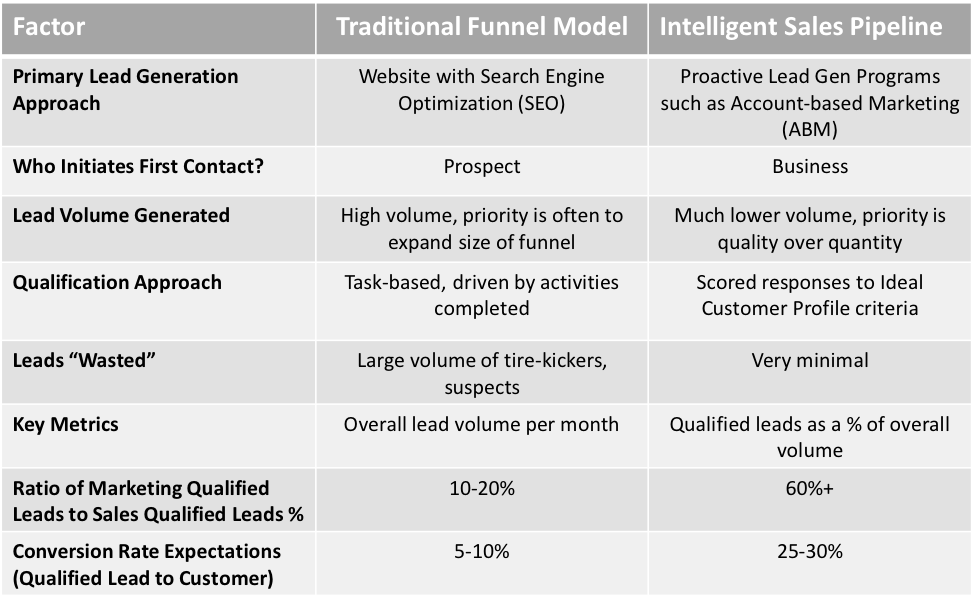
What Next?
Having challenges with your pipeline management, alignment of sales and marketing programs, customer acquisition, cost per lead, or overall revenue growth? If you are interested in learning more about the power of an Intelligent Sales Pipeline approach for your business, please contact one of us.
Please Note: “Intelligent Sales Pipeline” is a trademark of Mark S. Coronna.
Mark Coronna, Area Managing Partner & CMO, Chief Outsiders
Jeff Parris, Managing Principal, Sales Xceleration: Email Jeff
Daniel Steyn, Outsourced VP Sales, Sales Xceleration: Email Daniel
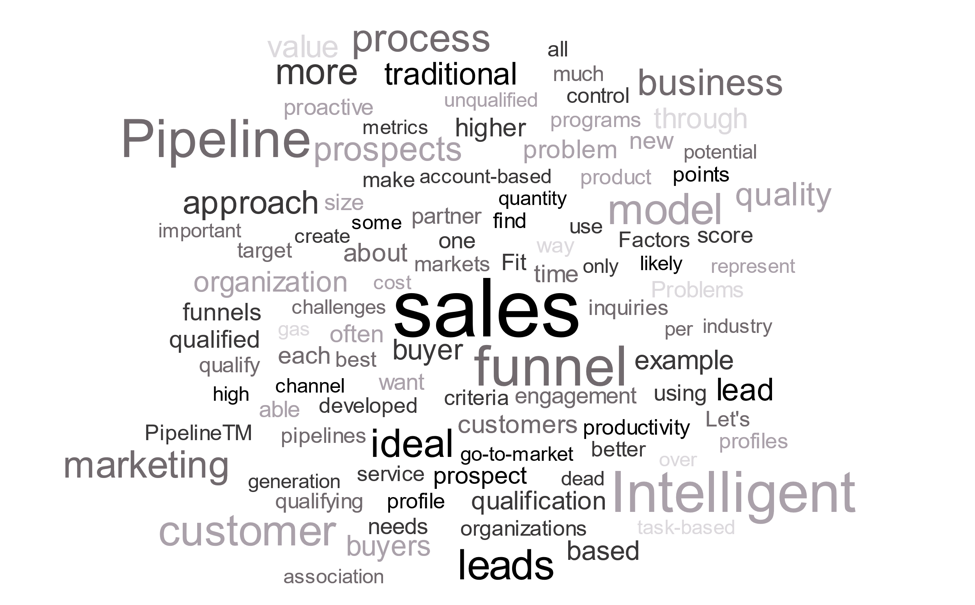
Topics: Business Growth Strategy, Sales Strategy, Leads, Sales Funnel
Mon, May 6, 2019- Press Releases
- Careers
- Case Studies
- Marketing Consultant Company
- Marketing Strategy Consultants
- Marketing Plan Consultants
- B2B Marketing Consultants
- Virtual CMO
- Marketing Consultant Outsourcing
- Fractional CMO
- What is a Fractional CMO
- Healthcare Marketing Consultant
- Marketing Consultant Houston TX Texas
- Marketing Consultant Texas TX
- Marketing Consultant Bay Area
- CEO Blog
- Ebooks Plus
- Executive Marketing Consultants
- Product Marketing Consultants
- B2C Marketing Consultants
- Virtual Marketing Consultants
- Senior Marketing Consultants
- Temporary CMO
- Hire a CMO
- Fractional CMO Salary
- Fractional CMO Responsibilities
- Marketing Consultant Austin TX Texas
- Marketing Consultant Dallas TX Texas
- Marketing Consultant San Antonio
- Helping Private Equity
- Private Equity Blog
- Leadership Team
- Privacy Policy
- Business Marketing Consultants
- Strategic Marketing Consultants
- Marketing Technology Consultants
- Sales and Marketing Consultants
- CMO Job Description
- CMO Salary
- Fractional CMO Agency
- Fractional CMO Services
- CPG Marketing Consultant
- Marketing Consultant San Diego
- Partners
Houston, TX 77056
© 2023 Chief Outsiders



